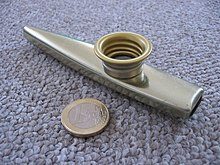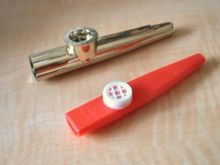Kazoo


The kazoo is a musical instrument that adds a "buzzing" timbral quality to a player's voice when the player vocalizes into it. It is a type of mirliton, which is a membranophone, one of a class of instruments which modifies its player's voice by way of a vibrating membrane.
Playing
A kazoo player hums, rather than blows, into the instrument.[1] The oscillating air pressure of the hum makes the kazoo's membrane vibrate.[1] The resulting sound varies in pitch and loudness with the player's humming. Players can produce different sounds by singing specific syllables such as doo, who, rrrrr or brrrr into the kazoo.
History


Similar hide-covered vibrating and voice-changing instruments have been used in Africa for hundreds of years, often for ceremonial purposes. A popular belief is that Alabama Vest, an African-American in Macon, Georgia, was the one who invented the kazoo around 1840. However, there is no documentation to support that claim.[2]
The first documented appearance of a kazoo was that created by an American inventor, Warren Herbert Frost,[2] who named his new musical instrument kazoo in his patent #270,543 issued on January 9, 1883. The patent states, "This instrument or toy, to which I propose to give the name 'kazoo' "..."[3] Frost's kazoo did not look like present-day submarine-shaped kazoos. The modern kazoo—also the first one made of metal—was patented by George D. Smith of Buffalo, New York, May 27, 1902.[2][4]
In 1916, the Original American Kazoo Company in Eden, New York started manufacturing kazoos for the masses in a two-room shop and factory, utilizing a couple of dozen jack presses for cutting, bending and crimping metal sheets. These machines were used for many decades. After 1985, they were retrofitted with safety devices as per the Occupational Safety and Health Administration, but the manufacturing process remained the same. By 1994, the company produced 1.5 million kazoos per year and was the only manufacturer of metal kazoos in North America.[5][6] The factory, in nearly its original configuration, is now called The Kazoo Factory and Museum. It is still operating, and it is open to the public for tours.[2]
In 2010, The Kazoo Museum opened in Beaufort, South Carolina with exhibits on kazoo history.[7]
Professional usage
The kazoo is played professionally in jug bands and comedy music, and by amateurs everywhere. It is among the acoustic instruments developed in the United States, and one of the easiest melodic instruments to play, requiring only the ability to vocalize in tune.[2] In North East England and South Wales, kazoos play an important role in juvenile jazz bands. During Carnival, players use kazoos in the Carnival of Cádiz in Spain and the Murga in Uruguay.

In the Original Dixieland Jass Band 1921 recording of Crazy Blues, what the casual listener might mistake for a trombone solo is actually a kazoo solo[2] by drummer Tony Sbarbaro or Red McKenzie (as also seen in their 1929 film short).[8] The Mound City Blue Blowers had a number of hit kazoo records in the early 1920s featuring Dick Slevin on metal kazoo and Red McKenzie on comb-and-tissue-paper (although McKenzie also played metal kazoo). The vocaphone, a kind of kazoo with a trombone-like tone, was occasionally featured in Paul Whiteman's Orchestra.[9] Trombonist-vocalist Jack Fulton played it on Whiteman's recording of Vilia (1931) and Frankie Trumbauer's Medley of Isham Jones Dance Hits (1932). The Mills Brothers vocal group originally started in vaudeville as a kazoo quartet, playing four-part harmony on kazoo with one brother accompanying them on guitar.[10]
The kazoo is rare in European classical music. It does appear in David Bedford's With 100 Kazoos, where, rather than having professionals play the instrument, kazoos are handed out to the audience, who accompany a professional instrumental ensemble.[2] Leonard Bernstein included a segment for kazoo ensemble in the First Introit (Rondo) of his mass. The kazoo was used in the 1990 Koch International and 2007 Naxos Records recordings of American classical composer Charles Ives' Yale-Princeton Football Game, where the kazoo chorus represents the football crowd's cheering. The brief passages have the kazoo chorus sliding up and down the scale as the "cheering" rises and falls.
In Frank Loesser's score for the 1961 Broadway musical comedy How to Succeed in Business Without Really Trying, several kazoos produce the effect of electric razors used in the executive washroom during a dance reprise of the ballad I Believe in You.
Jesse Fuller's 1962 recording of his song San Francisco Bay Blues features a kazoo solo,[11] as does Eric Clapton's 1992 recording of the song on MTV's Unplugged television show and album. Many Paolo Conte performances include kazoo passages.
Short kazoo performances appear on many modern recordings, usually for comic effect. For example, in his first album, Freak Out!, Frank Zappa used the kazoo to add comic feel to some songs[2] — including one of his best known, Hungry Freaks, Daddy. In the song Crosstown Traffic, from the album Electric Ladyland, Jimi Hendrix used a comb-and-paper instrument to accompany the guitar and accentuate a blown-out speaker sound.[2][12] The song Lovely Rita, from the Beatles album Sgt. Pepper's Lonely Hearts Club Band, uses combs-and-paper instruments.[2][13] Kazoo playing parodied the sound of a military brass band in the Pink Floyd song, Corporal Clegg.[14] Both Freddie Mercury and Roger Taylor play kazoos in Seaside Rendezvous, a pastiche of 1920s jazz, on Queen's 1975 album A Night At The Opera.
In the McGuinness Flint recording When I'm Dead and Gone, Benny Gallagher and Graham Lyle play kazoos in harmony during the instrumental break. The New Seekers' live track (Ever Since You Told Me That You Loved Me) I'm A Nut features a kazoo solo by singer Eve Graham. British singer-songwriter Ray Dorset, the leader of pop-blues band Mungo Jerry, played the kazoo on many of his band's recordings, as did former member Paul King.
One of the best known kazooists of recent times is Barbara Stewart (1941–2011).[2] Stewart, a classically trained singer, wrote a book on the kazoo, formed the "quartet" Kazoophony, performed kazoo at Carnegie Hall and on the Late Night with Conan O'Brien television show.[2][15] The steampunk band Steam Powered Giraffe has audience members play kazoos at some of their concerts. They also sell Kazookaphones, a standard kazoo with optional bugle horn and phonograph.
The kazoo is used regularly on the radio show I'm Sorry I Haven't a Clue, and kazoos are given to all audience members on show tours.
The video game Yoshi's New Island, released in 2014, has synthesized kazoos in several tracks of its soundtrack.
The American glam metal band Steel Panther released in December 2014 the Christmas track The Stocking Song, which includes a kazoo hook from Deck the Halls.
The Australian psychedelic rock band Tame Impala released a single in 2009 Sundown Syndrome , which includes kazoo rhythmic part.
Records
On March 14, 2011, the audience at BBC Radio 3's Red Nose Show at the Royal Albert Hall, along with a star-studded kazoo band, set a new Guinness World Record for Largest Kazoo Ensemble. The 3,910 kazooists played Wagner's Ride of the Valkyries and the Dambusters March.[16] This surpassed previous record of 3,861 players, set in Sydney, Australia in 2009.[17] The current record of 5,190 was set later the same night in a second attempt.[16]
On August 9, 2010 the San Francisco Giants hosted a Jerry Garcia tribute night, in which an ensemble of an estimated 9,000 kazooists played Take Me Out to the Ball Game.[18]
See also
Notes
- ^ a b How to Play Kazoo, Kazoos.com, 2013, accessed July 12, 2013
- ^ a b c d e f g h i j k l Harness, Jill, Great Moments In Kazoo History, Mental Floss, January 28, 2012, accessed July 12, 2013
- ^ Kazoo Patent, U.S. Patent Office, Washington, D.C., accessed July 12, 2013
- ^ Smith's Kazoo Patent, U.S. Patent Office, Washington, D.C., accessed July 12, 2013
- ^ Allen, Frederick (Winter 1994). "The Kazoo Monopoly". American Heritage of Invention & Technology. 9 (3). Retrieved 18 August 2014.
- ^ Wolk, Bruce H. (2009). Made here, baby! the essential guide to finding the best American-made products for your kids. New York: American Management Association. p. 258. ISBN 9780814413890. Retrieved 18 August 2014.
- ^ Jordan, Meredith (October 7, 2010). "Kazoo factory tunes in to Beaufort County". Bluffton Today. Retrieved October 26, 2010.
- ^ Mound City Blue Blowers "St. Louis Blues" 1929, performance video 1929, accessed July 12, 2013
- ^ Rayno, Don (19 December 2012). Paul Whiteman: Pioneer in American Music, 1930-1967. Scarecrow Press. pp. 608–. ISBN 978-0-8108-8322-2. Retrieved 12 July 2013.
- ^ The Mills Brothers - Inductees, Vocal Group Hall of Fame, accessed July 12, 2013
- ^ Peter Siegel, liner notes to Friends of Old Time Music (Smithsonian Folkways, SFW40160) Media.smithsonianglobalsound.org
- ^ Crosstown Traffic by Jimi Hendrix, Songfacts, 2013, accessed July 12, 2013
- ^ Lewisohn, Mark (1988). The Beatles Recording Sessions. New York: Harmony Books. ISBN 0-517-57066-1.
- ^ Corporal Clegg by Pink Floyd, Songfacts, 2013, accessed July 12, 2013
- ^ Stewart, Barbara (2006). The Complete How to Kazoo [With Kazoo]. Workman Publishing Company. ISBN 978-0-7611-4221-8. Retrieved July 12, 2013.
- ^ a b Largest Kazoo Ensemble, Guinness World Records, 2013, accessed July 12, 2013
- ^ BBC Radio 3's Red Nose Show breaks Guinness World Records title for largest ever kazoo ensemble, Big Red Nose Show, March 15, 2011, accessed July 12, 2013
- ^ Kukura, Joe (August 2010). "Giants Fans' Kazoos Create World Record Buzz". NBC Bay Area. NBC Universal, Inc. Retrieved 2010-08-14.
Additional reading
- Roberto Leydi; Febo Guizzi (2002). Gli strumenti della musica popolare in Italia. Libreria musicale italiana. ISBN 978-88-7096-325-0. Retrieved 12 July 2013. Invaluable survey of popular instruments in use in Italy, ranging from percussion, wind and plucked instruments to various noise makers.
- Kassinger, Ruth (30 January 2004). Build a Better Mousetrap: Make Classic Inventions, Discover Your Problem-Solving Genius, and Take the Inventor's Challenge. John Wiley & Sons. ISBN 978-0-471-42991-3. Retrieved 12 July 2013.
- Lombardi, Fabio (2000). Canti e strumenti popolari della Romagna bidentina: canzoni, ninne-nanne, filastrocche, balli, canti di nozze, stornelle, urli, bovare, strumenti e altro ancora, in una memorabile raccolta dei canti e della musica popolare della valle del Bidente. Il Ponte Vecchio. ISBN 978-88-8312-087-9. Retrieved 12 July 2013.
- Lombardi, Fabio (1989). I suoni perduti: mostra di strumenti musicali popolari romagnoli, Teatro Comunale G.A. Dragoni, 26-29 agosto 1989 : raccolti da Fabio Lombardi nella vallata del Bidente, Comuni di. Centro stampa provincia. Retrieved 12 July 2013.
- McGlynn, Don, 1986, The Mills Brothers Story, VHS, Kultur Videos, OCLC 26796337
External links
- Kazooco, kazoo museum and historic manufacturer
- "This is a kazoo!" Captain Kazoo: The world's largest private kazoo collection. More history, including details on the mirliton.
- The Kazoo Museum, website of the Beaufort, South Caroline kazoo museum
- Miss G and her Blues Kazoo, Woodstock Wooden Kazoo in Woodstock, New York
- Doc Kazoo and his Wooden Folk Kazoo, in Lake Seneca, Florida
- The Association of American Kazoologists, Information, including history, design and construction, of the kazoo

